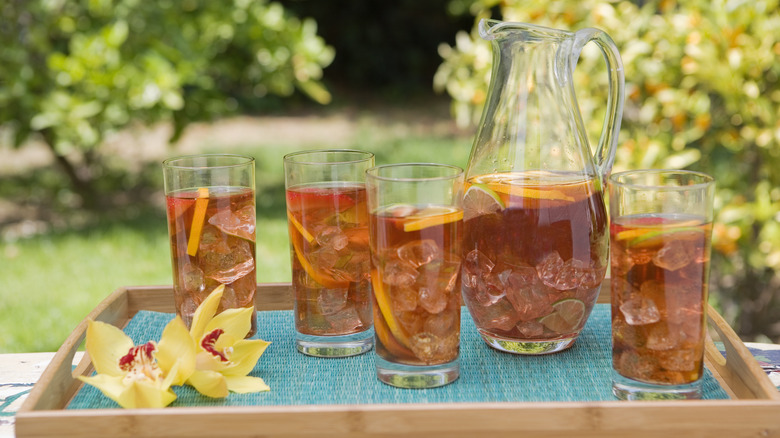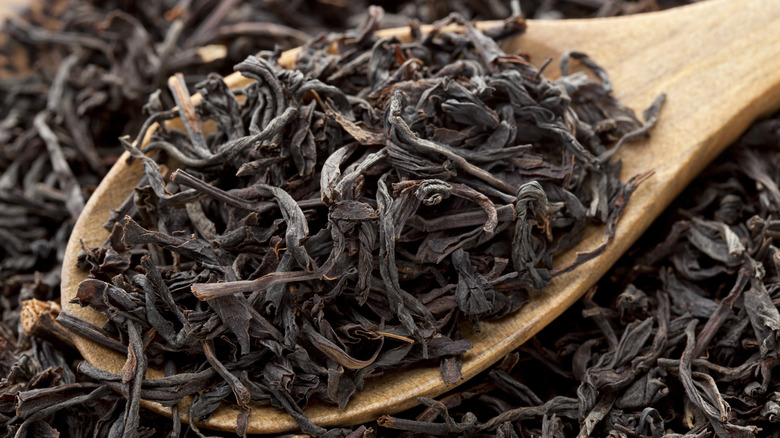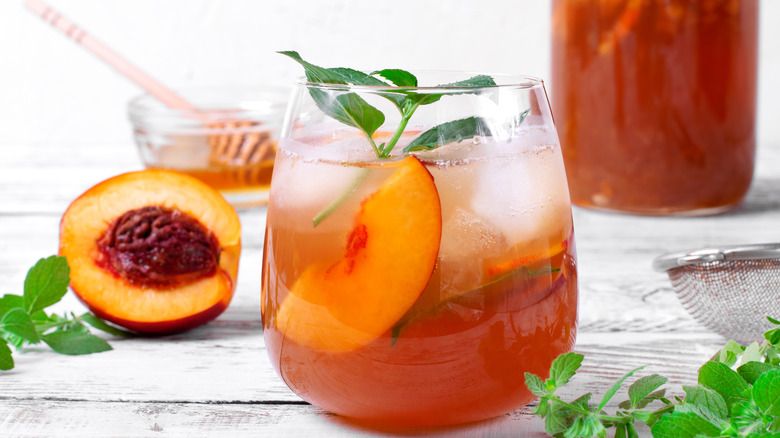The Best Kind Of Black Tea To Use When Making Iced Tea
Tea aficionados and Southerners alike know that iced tea is an art unto itself. Although the beverage contains minimal ingredients, it allows a great tea to shine. However, most tea drinkers who are willing to experiment with their leaves often focus on hot brews rather than iced versions. That's a shame, because black teas offer rich and varying flavors that shine when left to chill.
To elevate this thirst-quenching drink to new and gourmet heights, consider choosing your next tea leaf variety with care. Food Republic asked Tony Gebely, a world-renowned tea expert and founder of Tea Epicure, to weigh in on the black teas best suited for icing. "Yunnan black teas have a malty, chocolatey sweetness that makes an excellent iced tea that does not require the addition of sweeteners (unless you prefer a sweeter iced tea)," Gebely told us. "Qimen (often spelled Keemun) black tea also makes an amazing iced tea[.] I find this tea has a natural note of grilled peaches, and is also very palatable without the addition of sugar."
Savvy shoppers may notice these leaves marketed as "red" rather than "black." This is because, in China and other neighboring countries, the brew is named for its rosy hue. Don't let the name change throw you; the teas will deliver the same warm black tea flavors. Drinkers are welcome to stick with the usual baggies, but Gebely's recommendations are ideal for loose leaf brewing. Simply add leaves directly to water, and strain after they've finished steeping.
Your iced tea leaf options
Both of brewmaster Tony Gebely's recommended teas hail from China. Yunnan tea originates from Yunnan Province in the southwest, bordering several other famous tea-producing countries. The beloved tannin-rich teas from this area tend to be sweet and make perfect companions for desserts and afternoon treats, though they can also hold their own against savory and meatier snacks.
Yunnan black teas can also boast notes of fruit and leather, and have a honeyed flavor. As such, brewers may want to use the bee product to sweeten the iced tea and draw out more of the nectar's complexity — or pair a glass with a malted brownie to highlight caramel notes. Qimen is another famed black tea, grown in the eastern part of the country. Some brews offer a smoky, spicy sip with hints of red fruit, floral rose, and a lingering tang. Try serving it alongside an aromatic rose water-laced dessert to appreciate its flowery side and innate sweetness.
These teas have a loyal following, but if their robust tasting notes are too intense, Gebely has another suggestion. "Sencha is my favorite green tea to ice," he explained, referring to a Japanese green tea that can be citrusy, floral, or herbaceous. "There's something special about the cold sensation mixing with the umami vegetal notes of sencha (or even gyokuro)." Gyokuro is a heavier Japanese green tea known to burst with sweetness and umami when brewed cold.
Finishing touches for a sweet iced tea
Once you've secured the perfect batch of leaves, it's time to brew. Although there are a few mistakes to avoid when making iced tea, for the most part, the process is straightforward. And, if you do hit a snag, add baking soda to alleviate bitterness. Before you start steeping, however, take a moment to consider how sweet you'd like your tea.
According to tea expert Tony Gebely, there are two different brewing-style-dependent approaches to adding a sugary element, as sugar dissolves better in hot water than cold. For black teas made with hot water, dissolve sweeteners into the pitcher right after you've finished steeping, and while the water is still hot. For cold-brewed offerings, Gebely suggests using simple syrup to enhance the flavor before drinking. You can set aside any extra simple syrup and black iced tea to mix a hard sweet tea, too.
Gebely prefers his tea without any additives, but suggests an overlooked ingredient that drinkers might enjoy in their brew: fresh fruit. To draw out the peachy undercurrents of Qimen black tea, we suggest adding stone fruit wedges, raw or grilled. To impress dinner guests, you can also add berries or small fruits to ice cube molds, freeze them in water, and serve as a cooling garnish in the beverage.



